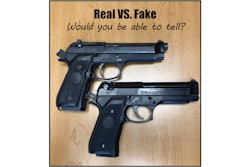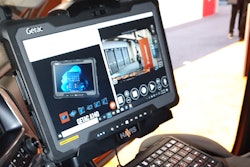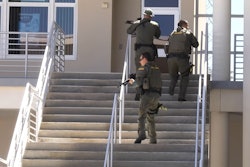A call comes in to 911—a neighbor reports a domestic disturbance at a home in the rural unincorporated area of the county. It's dusk—dinner time for many—and the homes are far enough apart for privacy, but near enough in proximity for a loud confrontation in one yard to be heard in the next.
Two deputies arrive in separate vehicles and approach the residence. Nice place. Fresh paint. Manicured lawn. Fancy cars.
Money. Status. Pride.
...and the sound of shouting.
Not good.
The senior deputy takes charge and leads her even younger male colleague to the front door, where they're met by a man in a suit. His silk tie is loosened around his reddened neck. He's agitated. In the background a woman is consoling crying children.
By the time a third deputy shows up, TASER AFID tags are scattered everywhere, both the man and the woman are in custody (charged with resisting arrest and assault on a peace officer), and CPS has been summoned to handle the kids.
Not good.
The reports written at the end of the shift will include narratives about a confrontational male subject, attempts at de-escalation, and a physical altercation involving husband, wife, and the two deputies first on the scene. What won't make it into writing is the fact that the whole thing went sideways when the deputies failed to recognize that their contact/cover plan was wrong from the start.
Kerry Mensior suggests that this incident—a somewhat fictionalized amalgamation of thousands of calls just like it—could have gone much more smoothly if the arriving deputies had known how to unlock the B.A.N.K. Code.
Mensior—a retired law enforcement veteran with three decades on the job and now executive director of the International De-Escalation Association (IDEA)—says, "The deputies didn't recognize that they were dealing with an 'Action' type person. These individuals value competitiveness. Some people work 'inside the box' and others are 'outside the box' but 'Action' people are like, 'What box?' No adult likes to be told what to do, but for 'Actions' in particular, these are trip wires that lead to use of force incidents."
For an officer, knowing what sort of personality type they're dealing with can have a tremendous impact on how well—or how poorly—a contact goes.
Decoding the B.A.N.K.
B.A.N.K. is—in a nutshell—a set of four basic personality types into which most people align. Those traits are Blueprint, Action, Nurturing, and Knowledge. While almost everybody has some element of all four traits, one of the four is the most dominant trait for any given individual. It's the setting they default to under stress.
"When you think of 'Blueprint' people think of architectural drawing systems and processes," Mensior says.
People in this category appreciate structure, stability, and rules, and may come in contact with police most often as reporting parties or witnesses. They respect authority and titles, and tend to have what are considered to be "traditional moral values" regarding right and wrong.
Mensior explains that while "Blueprint" individuals generally gravitate toward safety and typically stay within the confines of "the box," people who fall into the "Action" category are quite the opposite.
"There is no box," Mensior says, "because the box burned up from the rocket ship leaving the box. Think of fun, freedom, and flexibility. They enjoy competition, and for them image is important. They dress really well. This is a guy driving down the street in a red Lamborghini that you pull over a hundred percent of the time. Nobody drives a Lamborghini who's not an "Action" unless they're the mechanic working on it and taking it for a test drive."
Individuals who fall into the "Nurturing" category are—by definition—nurturing. They're social and gregarious and tend to have large circles of friend.
"Nurses," Mensior says, "and a lot of cops are nurturers. They're ones who say, 'I want to give back to the community.' Nurturers will volunteer for different things like parades and 10K runs and fundraisers. They're the moms standing with the girls selling Girl Scout cookies. They decorate the box and they give the box to somebody else."
"Knowledge" people thrive on information. While a "Blueprint" type will know what a law allows or doesn't allow, the knowledge person will strive to know how the law was passed, and when, and why, and by whom. These people appreciate logic, reason, and factual accuracy.
"They reengineer the box," Mensior says. "They're the scientists. They're the lawyers. They're the ones who need to know everything about the box."
Using the Code
Once a person's personality trait in the B.A.N.K. model is identified, the officer(s) can adjust their own language selection to match the person with whom they're speaking.
Before even doing that, though, it's useful for officers to identify themselves in the B.A.N.K. system.
As a sergeant, I would use it as a team-building activity," Mensior says. "I would have everybody on my squad …to do their bank code. Then we would gather together and we would discuss it. Everybody on the squad knew what everybody else's B.A.N.K. code was, so they understood what the other personalities were."
Mensior says that made the cohesiveness of the squad much better.
Going back to the above DV example, Mensior says, "What the deputies should have immediately recognized is they're dealing with somebody who does not like rules—does not respect women. At that point, we change the language we're speaking, and we begin speaking his language. They should have shifted roles—the female deputy should have taken a step back and the male deputy should have taken a step forward and they should have swapped contact and cover. Had they done that the interaction—guaranteed—would've gone much better than it did."
Mensior continues, "We train a lot on pre-attack indicators. What we also have to be trained on is, 'Who are we dealing with? How do we pick up on that?' B.A.N.K. Code is a rapid, split-second assessment. In fact, it is the only personality assessment on the market that is scientifically validated to predict the buying behavior of a person. Now you say, 'Wait a second, we're not selling anything.' Well, yeah, we are. Everything in life is absolutely a sale. Everything in law enforcement is selling. It's nothing more than having influence on someone to do something that you want them to do—something that's actually against their interests."
Mensior concludes, "We sell people into handcuffs all the time."
Decoding De-Escalation
Nearly every police organization in America has by now undergone some manner of mandatory de-escalation training. De-escalation has been incorporated into scenario-based training as well as the work some officers are now doing in virtual and augmented reality (VR and AR headsets).
De-escalation is such a ubiquitous buzzword now that at times its mere mention causes peoples' eyes to glaze over.
But it merits mention that successful de-escalation of a situation is made far more manageable when both parties are "speaking a common language."
Having an enhanced ability to accurately perceive a person's fundamental personality trait—Blueprint, Action, Nurturing, and Knowledge—can enable officers to achieve the most optimal outcome available at any given call for service.
















